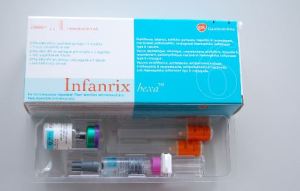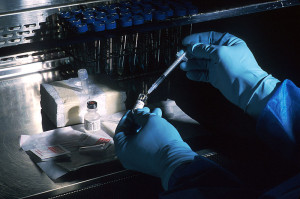nsnbc : Two doctors in New Delhi have exposed an attempt by a multinational drug manufacturer to conceal sudden deaths in infants following the administration of its vaccine.
 Jacob Puliyel, a pediatrician at the St. Stephen’s hospital and C. Sathyamala, an epidemiologist, have reported their finding in the peer reviewed Indian Journal of Medical Ethics. (HERE)
Jacob Puliyel, a pediatrician at the St. Stephen’s hospital and C. Sathyamala, an epidemiologist, have reported their finding in the peer reviewed Indian Journal of Medical Ethics. (HERE)
The vaccine in question, “Infanrix hexa,” — that combines diphtheria, tetanus, pertussis, hepatitis B, polio and influenza type B vaccines — is manufactured by GlaxoSmithKline (GSK) and was introduced in Europe in October 2000.
Puliyel and Sathyamala discovered the cover-up by analyzing data in the Periodic Safety Update Reports (PSUR) about the vaccine that its manufacturer GSK is required to regularly provide to the European Medicines Agency (EMA).
These confidential safety reports on this vaccine were received by Puliyel from Italian Dr. Loretta Bolgan who obtained them from EMA under the Freedom of Information Act – the Italian version of the Right to Information Act in India.
On analysis, the doctors found that the latest 19th safety report on ‘Infanrix hexa’ vaccine submitted by GSK (2015) has deleted deaths that were reported previously by the manufacturer in its 16th report (2012). They, however, note that it is not clear from the report how these deaths were deleted.
The authors Puliyel and Sathyamala note that ten years after the publication of a Center for Disease Control paper examining a relationship between MMR and autism, one of the authors William Thompson admitted that he and his co-authors had omitted statistically significant information – that African American males given the MMR vaccine before the age of 36 months, were at increased risk of autism.
After the Thompson and his colleagues found evidence of this increased risk, they deleted data of children without Georgia birth certificates (and so disqualified a disproportionate number of black children) and they presented their data saying there was no increased risk of autism. It is not clear whether the authors of the PSUR 19 performed some similar retroactive disqualification of children documented to have died in the PSUR 16.
“If these deaths had not been deleted, the deaths after vaccination would have been significantly higher than what was expected by chance. The manufacturer would have had to admit to the EMA that their vaccine was the cause of these excess deaths,” the authors report.
Puliyel and Sathyamala argue that the manufacturer “needs to explain the apparently faulty figures that it submitted to the regulatory authorities.
Until now the manufacturer has been claiming that the deaths reported after the vaccine are “coincidental” and that they would have taken place in these children even if they had not been vaccinated.
However, in their commentary in the journal, Puliyel and Sathyamala point out that their analysis has shown that 83 % of the reported deaths have taken place soon after vaccination in the first 10 days and only 17% happened in the next 10 days.
“If this were simply coincidental deaths then it would not all cluster immediately after vaccination but would have been distributed uniformly over the 20 day period.”
Puliyel and Sathyamala write that any argument that the sudden deaths after vaccination is offset against the lives saved by the vaccine is not acceptable in the same way it would be considered unethical to kill one person to use his or her organs for saving five other persons.
“Glossing over of the deaths after vaccination can prevent or delay evaluation of the vaccine’s safety profile and this has potential to result in more, unnecessary deaths which are difficult to justify ethically,” they say.
They point out that Hexavac – a similar vaccine manufactured by Sanofi Pasteur and introduced in the market also in 2000 was removed from the European market in 2005. It was found to have increased deaths of children within two days of vaccinating with it.
In the Indian context, the authors note that the Drug Controller General of India ( DCGI) should reconsider the current policy of automatically approving any drug licensed in the USA and Europe. “This reliance on due diligence by the EMA may be misplaced and needs to be re-evaluated.”
“Pentavac”, manufactured by Serum Institute of India and marketed in India, is similar to the now banned Hexavac and the Infanrix hexa reported here, except that the whole cell whooping cough vaccine is replaced by an acellular vaccine and it has a sixth component, the injectable polio vaccine.”
In the light of their finding, Puliyel and Sathyamala suggest that “it is crucial for the DCGI to be aware of the PSUR reports provided to the EMA and the concerns raised through this commentary.”
J/P & CH/L – nsnbc 05.09.2o17
nsnbc international is independent but depends on modest donations from readers like you. Please use the PayPal button to the right to support us with a one time donation or with a few coins per month. Thank you for your much-needed support. We could not continue without help from readers like you.
Source Article from https://nsnbc.me/2017/09/05/report-alleges-cover-up-of-infant-deaths-post-vaccination/
 RSS Feed
RSS Feed















 September 6th, 2017
September 6th, 2017  Awake Goy
Awake Goy 











 Posted in
Posted in  Tags:
Tags: 













